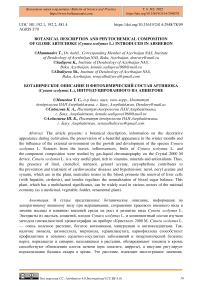Botanical description and phytochemical composition of globe artichoke (Cynara scolymus L.) introduced in Absheron
Автор: Mammadov Tofig, Sadigova Kemale, Albaliyeva Sh.
Журнал: Бюллетень науки и практики @bulletennauki
Рубрика: Биологические науки
Статья в выпуске: 5 т.8, 2022 года.
Бесплатный доступ
The article presents: a botanical description, information on the decorative appearance during cultivation, the preservation of a beautiful appearance in the winter months and the influence of the external environment on the growth and development of the species Cynara scolymus L. Extracts from the leaves, inflorescences, fruits of Cynara scolymus L. and the component composition were studied by gas-liquid chromatography on the Crystal 2000 M device. Cynara scolymus L. is a very useful plant, rich in vitamins, minerals and antioxidants. Thus, the presence of linol, citonellol, mirtenol, geranyl acetate, caryophyllene contributes to the prevention and treatment of cardiovascular diseases and hypertension; nerol, neryl acetate and synarin, which are in the plant, neutralize toxins in the blood, promote the renewal of liver cells (with hepatitis, cirrhosis), and insulin regulates the normalization of blood sugar balance. This plant, which has a multifaceted significance, can be widely used in various sectors of the national economy (as a medicinal, vegetable, fodder, ornamental plant).
Absheron, development, phytotherapy, medicine, importance
Короткий адрес: https://sciup.org/14124412
IDR: 14124412 | УДК: 581.192.1, | DOI: 10.33619/2414-2948/78/09
Текст научной статьи Botanical description and phytochemical composition of globe artichoke (Cynara scolymus L.) introduced in Absheron
Бюллетень науки и практики / Bulletin of Science and Practice
The diversity of soil and climatic conditions in Azerbaijan creates conditions for the planting and cultivation of a wide range of medicinal plants. The flora of Azerbaijan is rich in up to 40% of a variety of useful medicinal plants. In this sense, the flora of Azerbaijan is a source of medicinal, essential oils, in general, plant raw materials rich in biologically active substances. “If there are a thousand pains, there are a thousand and one medicines”, said our ancestors, who from ancient times used plants to treat their diseases. Knowledge and information about this have been accumulated as a result of many years of experience of our ancestors and passed down from generation to generation. Many years of public observation have shown that herbal medicines have a greater effect than synthetic drugs. The chemical composition of medicinal plants is very rich [6]. From this point of view, it is very important to cultivate medicinal plants on a large scale and study them on a scientific basis. At the same time, it is necessary to use medicinal plants both for valuable food and as a means of treatment [9]. Among the medicinal plants in the flora of Azerbaijan, C. scolymus L., which has the characteristics of multifaceted use, is not sufficiently planted and cultivated in our republic. C. scolymus L. has a special place in the plant collection of the Institute of Dendrology of Azerbaijan NAS. The Institute of Dendrology is located in the north-eastern part of the Absheron Peninsula. The Institute has a rich collection of Azerbaijani flora and plants imported from around the world.
Materials and methods
The study was conducted in the experimental field of the Institute of Dendrology on the species C. scolymus L. In our study, the taxonomic composition of the species C. scolymus L. was referred to as A. Engler-Prant I and the 2016 APG IV (Angiosperm Phylogeny Group IV) systems [10]. Phenological observations on the species under study were studied with reference to standard methods used in botanical gardens. To determine the heat resistance of the studied species was used K. A. Akhmatov’s method, P. A. Genkel’s method for determination of the drought resistance, and revised scale by E. O. Iskandarov was used to determine the perspective of introduction in cultural conditions [11, 12]. In order to carry out the research, extracts from the leaves and cluster of flowers were obtained at different stages of the vegetation, and oil was obtained from the fruits. The component composition of the extract from the leaves, the cluster of flowers and oil from the fruits was determined by gas-liquid chromatography of the Crystal 2000 M.
Results and discussion
According to Greek legend, Zeus, the god of the sky, fell in love with Sinara, the daughter of the earth, and invited her to Mount Olympus. One day, Sinara returns to Earth without Zeus’ permission. Enraged, Zeus turns him into a thorny plant, Sinara. In Greek it means “dog” (because its flowers and fruits fall to the ground during ripening), and in Italian it means “pinecone”. Cynara scolymus L. looks like thistle, people sometimes call it a thistle. Both plants belong to the Asteracea family [8]. However, the large petal-like leaves and large flowers are bluish, and the daisies are purple red in color.
Cynara L. is native to the Mediterranean countries. Up to 12 species are found in the middle belts of Europe, North and South America, and the Canary Islands. It is spread to other countries from Italy. There are 2 species of this plant in Azerbaijan: C. scolymus L. and C. cardunculus L. The most common is C. scolymus L. [7].
C. scolymus L. is a perennial herbaceous plant up to 2.5 m tall, with a blue-green surface. It is cultivated in Lerik, Shamakhi, Maraza, Absheron regions of the republic [4]. The stems and leaves are covered with dense hairs. The body is straight, fleshy, densely branched. The shaft has a root system, with a large number of side roots. The leaves are large, small, feathery, light blue on the surface, silvery at the base, densely hairy, growing up to 120 cm in length and 50 cm wide. The flowers are blue, purple, sometimes white, spherical, semicircular, in a large cluster of flowers, they cross pollinate. The cluster of flowers is 10-20 cm in diameter, spherical, semicircular. It blooms in June and bears fruit in July-August. The seeds are black, 5-8 cm long, ovate. The seeds contain up to 30% fat [2]. The weight of 1000 seeds is 45-55 g. Planted plants are propagated by seeds and by vegetative (in the absence of seeds). In the propagation of the plant, the method of reproduction of more seeds is widely used. The seeds of the plant are stored in moist sand at a temperature of 12 °C for 30-45 days before planting in the soil. The seeds of C. scolymus L. make the first germination 12-15 days after planting in the ground, and mass germination 30-35 days later. If this plant is agro-technically maintained, its height reaches 45-50 cm during the first growing season, and 80-90 cm during the second growing season.
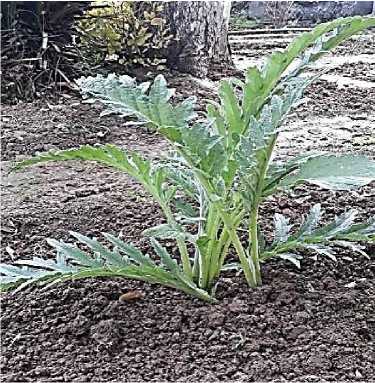
Figure 1. Annual and perennial growth of Cynara scolymus L. species
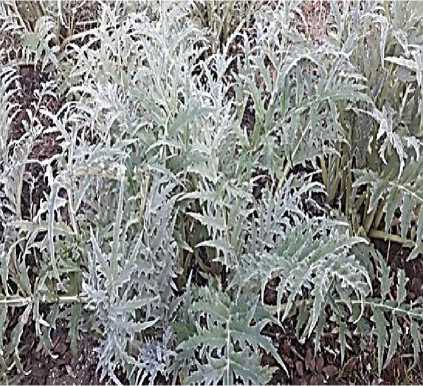
The plant can live in the same place for 30-40 years; it blooms and produces seeds. The vegetation period is 90-100 days. Phenological observations were made on the studied species of C. scolymus L. at different phases of vegetation, and the obtained results are reflected in Table 1.
In the process of development (phytogenesis) of all living organisms, they differ in their characteristics for the living conditions. Therefore, the optimal provision of each plant with complex living factors to go through different stages of development has a positive effect on productivity and improves the quality of its productivity [11].
Developmental factors are important in the developmental phases of the plant organism. Therefore, it is necessary to choose the living factors that are important in the developmental stages of each of the plants and use them as much as necessary. The main goal here is to clarify these factors at different stages of plant development, to determine whether they are mature and to provide the necessary growth factors. In this case, one can get high quality products from the plant. If there is fertile soil, normal water regime and optimal lighting conditions for the plant to grow well, but if there is not enough heat, the plant will not grow. Otherwise, if the plant is not supplied with water, the plant will stop growing, even if all environmental factors are met. From this point of view, it is important for plants to have the necessary environmental factors for normal development and abundant harvest.
Table 1
PHENOLOGICAL INDICATORS OF THE DIFFERENT STAGES OF VEGETATION OF C. scolymus L. species
|
Species |
Budding |
Flowering |
Seed ripening |
Vegetation period |
The growth of the plant |
|
|
beginning |
ending |
|||||
|
C. scolymus L. |
15.05.2021 |
10.06.2021 |
05.07.2021 |
15.08.2021 |
90–100 |
98 |
Despite being a heat- and light-loving plant, the plant is drought tolerant and frost tolerant. It retains its beautiful appearance in the winter months, does not lose its silvery-green color in the open field. In Absheron, the temperature in the winter months is 8–10° C. It should be noted that it does not require special care in cultivation; it is resistant to diseases and pests.
It is known that grasses play an important role in regulating air temperature in the soil. Covering the soil surface with trunks, leaves and straw is important in absorbing the sun’s rays. Absorption of heat radiation occurs not in the upper surface of the soil, but in the air layer where the plants are located, in which case the soil surface receives only 20% of the radiation. The spread of perennial grasses on the slopes gives high soil fertility and protects the soil from erosion. In addition, the surface part of the plant species protects the soil from erosion due to the formation of a large number of leaf cover. In this regard, the plant is considered very effective in the fight against soil erosion. Wind is the main environmental factor in environmental changes in Absheron. Strong winds have a negative effect on the plant, when the stem of the plant bends, the leaves and flowers dry out, and as a result it does not bear fruit. However, because of its thick trunk and leaves, strong winds cannot damage this plant [12].
Nitrogen compounds in the soil are of great importance in the study of biological and ecological properties of plants. When you provide them with nitrogen, the amount of carbohydrates begins to decrease. When reducing is provided, surface organs develop better. The growth process of grasses and the formation of surface shoots increase the number of leaves, the expansion of their surface, increasing the succulent character, increasing the amount of both water and chlorophyll, creating shade-loving conditions, and as a result the mass of surface organs exceeds the mass of underground. Vegetation goes well and ends at low temperatures when the plants are normally supplied with nitrogen. It is an evergreen plant and continues to grow normally in nutrient-poor soils. The component composition of the extract obtained from the leaves, cluster of flowers and oil obtained from fruits of Cynara scolymus L. was analyzed by Crystal 2000 M gas-liquid chromatography method, the results are given in Tables 2, 3, 4 and in Figure 2–4.
Table 2
RESULTS OF THE ANALYSIS OF THE EXTRACT FROM THE LEAVES OF Cynara scolymus L. ON GAS-LIQUID CHROMATOGRAPHY CRYSTAL 2000 M
|
Duration (with minutes) |
Detected component |
Area (with percentage) |
|
8.550 |
a-pinen |
3.256 |
|
13.981 |
cyclohexanone 5-m-2 (1-m e), - cis |
31.024 |
|
14.555 |
cariophyllene |
4.486 |
|
15.173 |
terpinen |
4.86 |
|
17.214 |
mirtenilacetate |
30.295 |
|
18.167 |
geranyl oleate |
4.994 |
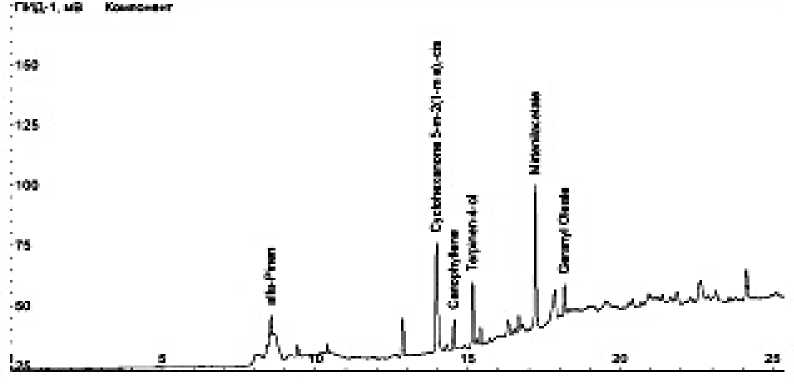
Figure 2. Chemical composition diagram of the extract from the leaves of Cynara scolymus L. in gasliquid chromatography Crystal 2000 M
Table 3
RESULTS OF THE ANALYSIS OF THE EXTRACT FROM THE LEAVES OF Cynara scolymus L. ON GAS-LIQUID CHROMATOGRAPHY CRYSTAL 2000 M
|
Duration (with minutes) |
Detected component |
Area (with percentage) |
|
13.979 |
cyclohexanone 5-m-2 (1-m e), - cis |
85.772 |
|
15.148 |
citronellol |
6.684 |
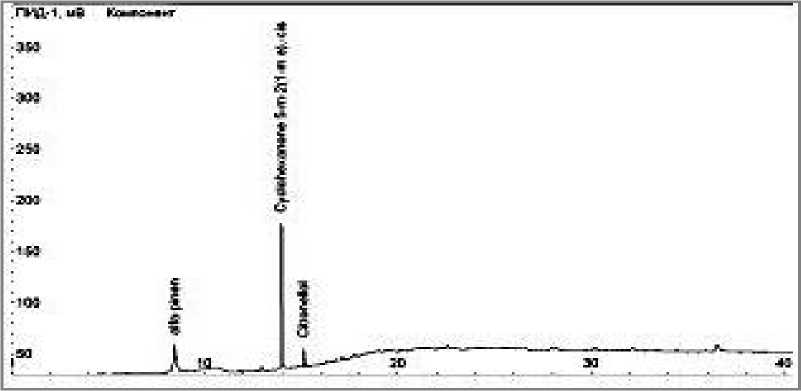
Figure 3. Chemical composition diagram of the extract from the cluster of flowers of Cynara scolymus L. in gas-liquid chromatography Crystal 2000 M.
Table 4
RESULTS OF THE ANALYSIS OF OIL OBTAINED FROM THE FRUITS OF Cynara scolymus L.
IN CRYSTAL 2000 M GAS-LIQUID CHROMATOGRAPHY
|
Duration (with minutes) |
Detected component |
Area (with percentage) |
|
8.401 |
a-pinen |
3.009 |
|
9.899 |
carene-3 |
0.032 |
|
10.151 |
a-terpinen |
2.506 |
|
13.147 |
terpinolen |
2.696 |
|
13.330 |
cyclohexanone 5-m |
5.937 |
|
14.087 |
linaool |
9.797 |
|
14.614 |
cariophyllene |
3.156 |
|
15.007 |
bornyl acetate |
1.933 |
|
15.149 |
citonellol |
3.156 |
|
16.117 |
a-terpineol |
1.426 |
|
16.175 |
synarine |
12.763 |
|
16.186 |
estagole |
2.225 |
|
16.275 |
kamfen |
1.841 |
|
16.417 |
mirtenol |
1.411 |
|
16.559 |
nerol |
9.316 |
|
16.890 |
geraniol |
0.596 |
|
16.969 |
camphor |
0.253 |
|
17.197 |
citonelly butyrate |
11.591 |
|
17.595 |
a-terpenilacetat |
0.090 |
|
18.303 |
geranyl oleate |
0.889 |
|
19.705 |
neril acetat |
0.276 |
|
19.989 |
citronllyl tiglate |
0.078 |
|
20.234 |
geranilacetat |
0.257 |
|
21.375 |
cedrol |
0.738 |
|
23.638 |
1 h cycloprop[E]azulen-7-ol, decahydro-1,1,7-trim-4m |
0.237 |
|
24.015 |
thymol |
1.412 |
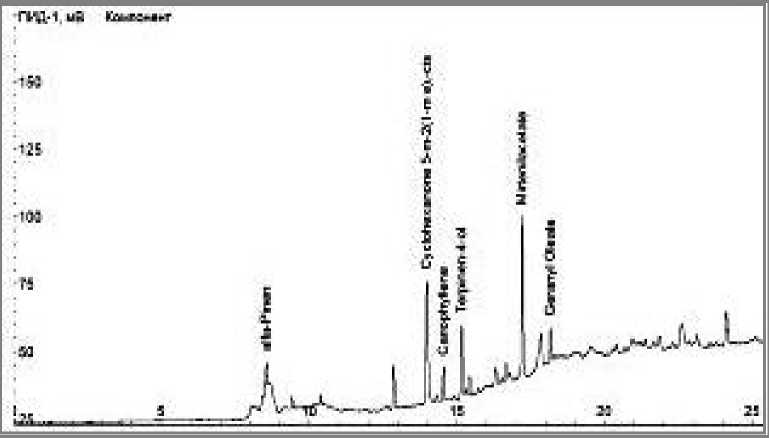
Figure 4. Chemical composition diagram of oil obtained from the fruits of Cynara scolymus L. in Crystal 2000 M gas-liquid chromatography
C. scolymus L. species, which are of great importance, are very rich in vitamins, minerals and antioxidants: cinararin glycosides, tannins, sugars, fatty and resinous substances, organic acids, provitamins A, C and B group vitamins, etc. can be shown [3].
In folk medicine, its leaves, flowers, fruits and roots are used to treat various diseases. Due to its effect on the human body, its water is very useful. It protects the liver against toxins, lowers blood sugar, reduces the risk of cardiovascular disease and strengthens the immune system. The presence of inulin helps to normalize insulin levels. Its use increases the amount of vitamins B 3 and B 6 in the body, which protects the health of cells and helps to regenerate damaged cells. The plant is used as choleretic remedy, in the treatment of kidney diseases, against atherosclerosis, lowering cholesterol level, etc. [1, 5]. It is a plant that gives good honey. It is used in the manufacture of dyes, fibers, soaps for obtaining colors.
Conclusion
As a result of the research work, it was determined that Cynara scolymus L . was of normal height and development when provided with agro-technical care in Absheron conditions and no special care was required in its cultivation. This plant not only gives a decorative look to the environment, but also retains its beautiful, charming appearance in the winter months. Oil was extracted from the leaves of the cultivated Cynara scolymus L. species, and extracts from the flowers and fruits of the basket flower. The component composition of substances (extract, oil) obtained by gas-liquid chromatogram method Crystal 2000 M was studied. Studies show that they are rich in vitamins, minerals and antioxidants, but also very useful. Thus, the presence of linaol, citonellol, mirtenol, heranyl acetate, cariophyllene helps in the prevention and treatment of cardiovascular diseases and hypertension, nerol, neryl acetate and synarine regulate the neutralization of toxins in the blood, the healing of liver diseases (hepatitis, cirrhosis), especially the renewal of liver cells, and insulin regulates the normalization of blood sugar balance. This plant, which has a multifaceted importance, can be widely used in various sectors of the economy (as a medicine, vegetable, livestock feed, ornamental plant).
Список литературы Botanical description and phytochemical composition of globe artichoke (Cynara scolymus L.) introduced in Absheron
- Babaev, N. F., Konyushkov, N. S., Lapin, M. M., & Sukortseva, K. F. (1955). Osnovy rastenievodstva. Moscow. (in Russian).
- Yusifov, A., Mamedov, K. S., Gasymov, T. P., & Rzaev, M. F. (2013). Fundamentals of crop production. Baku. (in Azerbaijani).
- Kasyanov, G. I., Akhmedov, M. E., & Yaralieva, Z. A. (2016). Innovatsionnaya tekhnologiya polucheniya krioporoshkov iz plodov i yagod. Problemy razvitiya APK regiona, 28(4), 119-123. (in Russian).
- Damirov, I. A. (1990). Medicinal value of fruits and vegetables of Azerbaijan. Baku. (in Azerbaijani).
- Kolesnikova, I., & Saparklycheva, S. E. (2018). Pryanye dikorastushchie rasteniya. Molodezh' i nauka, (2), 13-13. (in Russian).
- Gasymov, M., & Mamedov, T. (2014). Phytotherapy. Baku. 4-7. (in Azerbaijani).
- Mamedov, T., & Gyulmamedova, Sh. (2021). The study of ornamental plants in the garden of the Apsheron Philharmonic. Journal of science. Lyon, (16-1), 10-14. (in Azerbaijani).
- Mikhunova, D. V. (2019). Mythologisms in Latin and Russian names of medicinal plants. (in Azerbaijani).
- Talybov, T. G., & Ibragimov, A. Sh. (2008). Taxonomic spectrum of the flora of the Nakhichevan Autonomous Republic (Higher spore, gymnosperms and angiosperms). Nakhchyvan. (in Azerbaijani).
- Mamedov, G. Sh., & Khalilov, M. Yu. (2005). Ecology and environmental protection. Baku. (in Azerbaijani).
- Allakhverdiev, A. S. (1973). Derev'ya i kustarniki v ozelenenii Apsherona. Baku. (in Russian).
- Akhmatov, K. A. (1972). Polevoi metod opredeleniya zharoustoichivosti rastenii. Byul. Gl. botan. sada, (86), 24-26. (in Russian).

